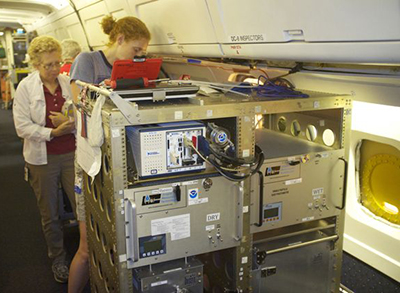Atmospheric Composition & Chemical Processes: Instruments
Single Particle Soot Photometer (SP2)

Black carbon (BC) in the atmosphere plays an important role in global climate change, affecting climate radiative forcing directly through its absorption of solar radiation and indirectly by affecting cloud processes. Measurements of BC help elucidate not only its direct impact on climate, but also bear on both its possible indirect (as CCN/IN) and semi-direct effects. We perform measurements with a small collection of Single Particle Soot Photometers (SP2; Droplet Measurement Technologies, Boulder, Colorado).
The SP2 is a laser-induced incandescence instrument primarily used for measuring the BC mass content of individual particles. It is able to provide this data product independently of the total particle morphology and mixing state, and thus delivers detailed information not only about BC loadings, but also size distributions, even in exceptionally clean air. The instrument can also provide the optical size of individual particles containing BC, and identify the presence of coatings associated with the BC fraction (i.e. identify the BC's mixing state). Since its introduction in 2003, the SP2 has been substantially improved, and now can be considered a highly competent instrument for assessing BC loadings and mixing state in situ.
At NOAA CSL, we have coupled two SP2s, and have them operating in parallel at different relative humidities to quantify interactions of BC-containing particles with water vapor (nominally κBC). This composite instrument, called the Humidified Dual-SP2 (HD-SP2) draws upon the individual-particle detection of the SP2 to maximize sensitivity, and provides continuous dry and humidified sampling of all accumulation mode particles containing BC. Note that the κBC information extracted is not merely that of the bulk-material internally mixed with BC because the HD-SP2 can differentiate different classes of BC-containing particles within the whole distribution. For example, if fresh fossil-fuel emissions are mixed with aged air, a bimodal shift in optical size with humidification occurs, due to the different amounts and κBC of the coating materials associated with the different types of BC aerosol.

Refer to the single SP2 system shown schematically. Ambient air is drawn through an intense intracavity laser (a diode-pumped Nd:YAG laser operating in a Gaussian TEM-00 mode at 1.064 µm wavelength). Aerosol particles in the air enter the laser singly, and there scatter laser light according to their size and composition. The quantity of scattered light, and its evolution in time, is recorded. When black carbon (BC) enters the laser, it is heated to vaporization (~3500K), emitting blackbody radiation (incandescent light) in quantities directly related to its mass, regardless of particle morphology or mixing state. The color of this radiation is detected and used to deduce the vaporization temperature of the particle as a constraint on its composition. A detector system developed by NOAA is used to optically size BC-containing particles, before they are perturbed by laser heating. This allows quantification of the amount of non-BC material (interpreted as coating thickness via shell-core Mie theory) associated with each BC core, and its impact on the optical properties (including absorption cross-section) of the BC-component.
The thickness of coatings on a BC core is related to the core's history and source; freshly emitted BC tends to be relatively bare and then accrues additional coating materials with time. Coatings increase BC's absorption of sunlight, and their hygroscopicity is a microphysical parameter that dramatically affects the likelihood of BC's removal through wet deposition. Hence coating thickness and hygroscopicity (κBC) affect BC's concentration and ultimate impact on climate. κBChas not been measured from an airborne platform before.
Performance characteristics of the HD-SP2
| Operational altitude | Ground - 21 km (1013 hPa – 50 hPa) | |
| Flight duration | 12 hours | |
| Weight | 210 lbs for the two SP2s and the humidifier forming the HD-SP2 | |
| BC Aerosol data products |
| |
| Maximum particle event rate | 20,000 s-1 | |
| BC mass detection range | 0.5 - 680 fg (corresponding to 0.08 - 0.9 µlm mass-equivalent diameter assuming a 2 g/cc density) |
- Stratospheric Aerosol processes, Budget and Radiative Effects (SABRE) 2022 (NOAA)
- Asian Summer Monsoon Chemical & CLimate Impact Project (ACCLIP) 2021 (NASA)
- Fire Influence on Regional to Global Environments and Air Quality (FIREX-AQ) 2019 (NOAA/NASA)
- Atmospheric Tomography Mission (ATom) 2016 - 2018 (NASA)
- Fire Influence on Regional and Global Environments Experiment (FIREX) FireLab 2016 (NOAA)
- Korean - US Air Quality Study (KORUS-AQ) 2016 (NASA)
- Twin Otter Projects Defining Oil/gas Well emissioNs (TOPDOWN) 2014 (NOAA)
- Studies of Emissions and Atmospheric Composition, Clouds and Climate Coupling by Regional Surveys (SEAC4RS) 2013 (NASA)
- Southeast Nexus (SENEX) 2013 (NOAA)
- Deep Convective Clouds & Chemistry (DC3) Experiment 2012 (NSF/NASA)
- Qinghai Lake Measurements 2011 (Institute of Earth Environment, Chinese Academy of Sciences (IEECAS))
- HIAPER Pole-to-Pole Observations (HIPPO) of Carbon Cycle and Greenhouse Gases Study 2009/2010/2011 (NSF/NCAR)
- Mid-latitude Airborne Cirrus Properties Experiment (MACPEX) 2011 (NASA)
- California Research at the Nexus of Air Quality and Climate Change (CalNex) 2010 (NOAA)
- Aerosol, Radiation, and Cloud Processes affecting Arctic Climate (ARCPAC) 2008 (NOAA)
- Tropical Composition, Cloud and Climate Coupling (TC4) 2007 (NASA)
- Texas Air Quality Study / Gulf of Mexico Atmospheric Composition and Climate Study (TexAQS/GoMACCS) 2006 (NOAA)
- Costa Rica - Aura Validation Experiment (CRAVE) 2006 (NASA)
- Aura Validation Experiment (AVE) 2004 (NASA)